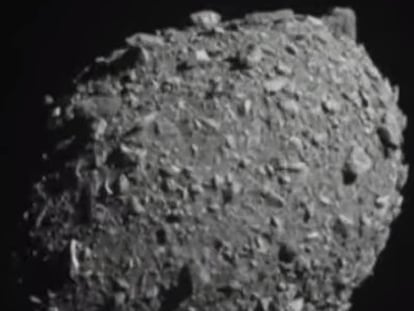NASA’s DART probe creates man-made ‘comet’ behind target asteroid Dimorphos
The impact of the 600-kilogram device was equivalent to two and a half tons of dynamite, sending tons of debris into space that now forms a 10,000 km tail

Among the thousands of asteroids that revolve around the Sun, there is something for everyone. As large as minor planets (Ceres – designated a dwarf planet – Pallas, and Vesta) or minute; solitary or accompanied by tiny satellites; solid or simple accumulations of loose fragments. But there is probably only one that is accompanied by something resembling a comet, with a 10,000-kilometer (6,213-mile) tail wagging in the solar wind, and which furthermore is of artificial origin, caused by the hand of mankind.
This was the result of the collision of NASA’s DART probe with a small asteroid called Dimorphos. On September 26 the probe, which weighs 600 kilos, smashed into the 10-million ton satellite. The contrast in size was such that logic would dictate DART would have little effect on Dimorphos.
But DART was traveling at a speed of about 6 kilometers per second, while Dimorphos was moving landuidly in its orbit at around 20 centimeters per second. The collision caused a cataclysm: colliding with the asteroid in a counter-clockwise direction, DART’s impact resulted in the satellite slowing down slightly, which in turn caused its displacement to a lower orbit and a reduction in its orbital timeline of just over a minute. Exactly how much Dimorphos’ trajectory around its binary asteroid, Didymos, has been disrupted is yet to be determined via a network of giant telescopes and radar. NASA has scheduled a press conference on October 11 at which more data will be provided.
Dimorphos does not appear to be a compact body, but more a mountain of rubble loosely held together by its own gravity. One theory suggests that it was formed from debris expelled by its older companion, Didymos. The larger asteroid, some 780 meters in diameter, is shaped like a spinning top with a large bulge at its equator, perhaps as a result of the high speed at which it rotates. Over the course of millions of years, small fragments could have been ejected into space; some of these would have formed an unstable orbit around the larger satellite and over time would have collapsed to form what is now Dimorphos.
Our last post was Monday's observations of the debris from the #DART impact on Didymos. Courtesy of @WesternU's Rob Weryk, this gif is last night's observations with MegaCam. Rob and Richard Wainscoat from @UHIfA plan continued observations of the asteroid. pic.twitter.com/2JwWaIaAWd
— CFHT (@CFHTelescope) September 28, 2022
The Didymos-Dimorphos binary system remains barely held together by the effect of mutual gravity. Dimorphos rotates just over a kilometer above the surface of its primary. Seen first hand, every pass it makes – once every 12 hours or so – must be an eerie yet majestic spectacle: a flying mountain streaking across a landscape of loose rocks and rubble.
The images relayed back to earth by DART’s in-flight cameras show that neither asteroid has much in the way of flat plains. Both consists largely of piles of rocks with no order or structure. There is no regolith – the fine dust that abounds on the Moon and other celestial bodies. With their extremely low gravity, the slightest graze would be enough to launch chunks of rock into space.
DART’s impact was not exactly a tickle. The collision caused dozens of tons of ore to be ejected into space, forming a halo around Dimorphos. A crater measuring perhaps a hundred meters in diameter will have been carved out of the asteroid. The energy generated by the collision is estimated to be roughly equivalent to the detonation of over two and a half tons of dynamite: not as powerful as a small atomic bomb, but enough to have rocked the entire satellite and changed its profile, in honor of its name: Dimorphos means “two forms.”
Another result of the experiment is less obvious: Dimorphos always presents the same face to its companion asteroid, as the Moon does with the Earth. This is the result of tidal forces exerted by one on the other. Almost all satellites in the Solar System are in the same situation. But it is likely that DART’s impact, coupled with other more subtle effects, will have upset that balance. Dimorphos may now be wobbling in what is known as “chaotic movement:” that is, unpredictably. It is not very common, but it has been observed in other cases, especially that of Hyperion, one of Saturn’s moons; Nereid, Neptune’s third-largest satellite, and almost all of the smaller bodies in orbit around Pluto.
What will happen to the material expelled into space? Initially, as if it were the jet of a rocket, it must have contributed in part to slowing Dimorphos down. When caught in a vacuum, the small satellite’s gravity is so weak that it would take days, if not weeks, for the material to fall to its surface. The majority of it will remain floating in space, accompanying Dimorphos in its orbit. Didymos’ gravitational pull is also not strong enough to attract the debris to it, or for it to form a ring around the larger asteroid, which would be a beautiful sight, but the laws of celestial mechanics are fairly rigid on this point.
Once in the vacuum, the expelled material is subject to other celestial forces. The most important of these is radiation pressure and the wind of subatomic particles emanating from the Sun. Both are responsible for the shaping of comet tails, whose length can measure millions of kilometers. Some tails are formed by faint plasma and these always extend in the opposite direction to the Sun; others are made up of dust particles with low inertia torn from the cometary nucleus that therefore tend to follow somewhat curved paths.
In the case of Dimorphos, its debris tail is already under pressure from solar radiation. It stretches for about 10,000 kilometers until it eventually dissolves into the void. As things stand, Didymos is the only known asteroid in the entirety of space that can boast of having a small “comet” orbiting around it.
Tu suscripción se está usando en otro dispositivo
¿Quieres añadir otro usuario a tu suscripción?
Si continúas leyendo en este dispositivo, no se podrá leer en el otro.
FlechaTu suscripción se está usando en otro dispositivo y solo puedes acceder a EL PAÍS desde un dispositivo a la vez.
Si quieres compartir tu cuenta, cambia tu suscripción a la modalidad Premium, así podrás añadir otro usuario. Cada uno accederá con su propia cuenta de email, lo que os permitirá personalizar vuestra experiencia en EL PAÍS.
¿Tienes una suscripción de empresa? Accede aquí para contratar más cuentas.
En el caso de no saber quién está usando tu cuenta, te recomendamos cambiar tu contraseña aquí.
Si decides continuar compartiendo tu cuenta, este mensaje se mostrará en tu dispositivo y en el de la otra persona que está usando tu cuenta de forma indefinida, afectando a tu experiencia de lectura. Puedes consultar aquí los términos y condiciones de la suscripción digital.










































